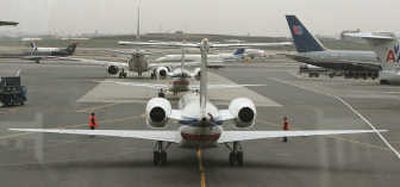FAA weighs rationing NYC flights

NEW YORK – Like a game of musical chairs, runways at New York City’s three regional airports are overbooked on a daily basis. And bottlenecks there now cause problems nationwide.
U.S. Transportation Secretary Mary Peters is scheduled to deliver a report to the president next week, and officials have told the airlines she is all but certain to recommend reinstating hourly flight limits at John F. Kennedy International.
Industry experts said that, depending on the program’s final shape, flight caps could make it harder for new carriers to expand in New York and force established airlines to be more selective about where they fly.
The end result, Bear, Stearns & Co. analyst Frank Boroch said, could be a cooling-off of the fare wars that have made air travel to the city relatively cheap. Passengers may see prices go up slightly, but Boroch suggested the sacrifice might be worth it if their planes, now routinely hours late, arrive on time.
That opinion is not shared by officials at airlines hoping to grow in New York. Caps, they say, will almost certainly mean limited availability of slots to newcomers.
“What this basically means is that if you have a small airline and you want to serve New York, you can forget it,” said Edward Faberman, a spokesman for the Air Carrier Association of America.
U.S. transportation officials have been saying for weeks that Kennedy, LaGuardia and Newark Liberty have been pushed past their breaking points by the fast expansion of carriers like JetBlue. Fare wars have lured so many fliers that runways at all three airports are now essentially overbooked for several hours each day.
Prior to Jan. 1, the airlines weren’t allowed to schedule more than 86 operations per hour during peak travel times. Transportation officials have suggested Kennedy can actually handle no more than 81 flights per hour, far fewer than the 100 or more that are now scheduled during the busiest times of day.
Hourly flight limits already exist at LaGuardia, and officials said similar caps are also likely to be added to Newark.
The caps could, in theory, reduce delays by keeping the airlines from over-scheduling, but the restrictions would raise the question of how the government would go about distributing the available slots. DOT officials have told airline executives that one option could be auctioning slots to the highest bidder.
It isn’t yet clear who could legally collect the money from such a scheme, or what it would mean for airlines with questionable ability to pay prices likely to exceed $1 million per slot.
Any auction plan would likely face a legal challenge from major carriers, who have spent billions of dollars developing terminals and establishing routes. The Air Transport Association said that if the slots for those routes were then auctioned off, it would make those investments worthless.
Caps and auctions are also opposed by politicians representing small cities that could see less service if airlines are forced to pay top dollar for each takeoff or landing.